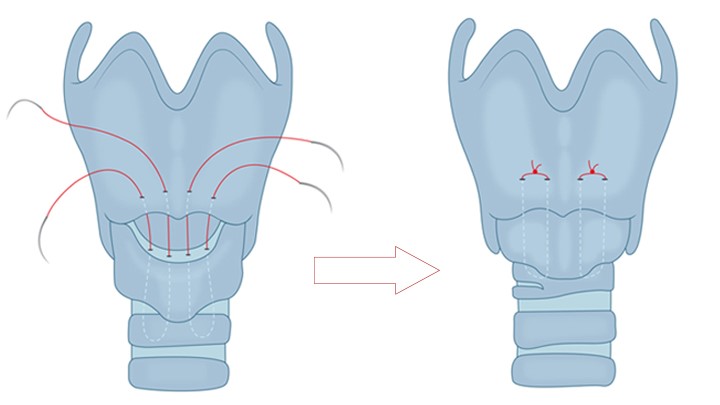Cricothyroid approximation (CTA)

Year 4 begins for me post voice feminisation surgery (cricothyroid approximation) I thought I would share my experiences.
Before I totally dive in to my conclusion, it’s only fair I should explain how I got to where I am today.
I began with a very low voice around 110hz…Darth Vader territory. Yeah testosterone really went for my throat big time eh. How much that influenced the outcome is a big question…I will look at that later in this article.
A bit of background info on voice feminisation surgery:
I want to ‘pass’ as female orally, it was never my choice or option to sound male so it has always been on my list for ‘correction.’
For the first 13yrs of my life, like most kids, it wasn’t an issue as boys/girls sounded pretty much the same.
That all changed in my case, in a few days…inconveniently for me as it happened during a school trip to Switzerland aged 13. I left on the trip as a soprano in the school choir and returned as a baritone; for 4days I couldn’t speak at all! For most boys, voice ‘breaking’ is a welcome start to becoming a man. I didn’t see it that way…and I hated it.
What had happened?
Testosterone had modified my vocal chords and vocal tract…and it’s permanent people. Once done it can’t be reversed. From then until some 7months ago, that has been my life. The voice I had and disliked intensely.
There is only one way to change that…and it’s surgery. Now you can modify your voice by ‘training’ your R1, R2, R3 and vocal chords…I know and I am doing that now. But to make any physical change to the voice, and revise the transformation by testosterone, you have two major options available, these are the two on offer in general: Open laryngoplasty and cricothyroid approximation (CTA)

CTA: ‘The goal of this operation is to surgically move the thyroid cartilage closer to the cricoid with non-absorbable stitches. The vocal cords are not directly touched but passively stretched. This procedure results in increased vocal pitch by stimulating the contraction of the cricothyroid muscle with the suture. This increases the distance between the vocal fold attachments and raises the tension of the vocal fold.‘
I had one option
I didn’t chose CTA originally, I wanted Open laryngoplasty. I had signed up and paid for that, however, after a last minute consultation the surgeon insisted laryngoplasty would be too difficult in my case. His recommendation was for CTA.
On the face of it CTA is a much lower risk than Open laryngoplasty. And, should it be needed, it is reversible. The downside being, for 20% of cases it doesn’t improve the pitch. ie. it doesn’t work. I’ve never considered myself a lucky person so all I could see was the 20% fail rate, not the 80% success. Which was it for me? Read on…
If you are considering CTA here are my experiences with the surgery. The bits they don’t tell you in the brochure.
I can say the surgery was done under general anaesthetic and I had no pain or discomfort afterward. For a week after the surgery you are forbidden to speak and the dressing on the throat covers the scar. Eating, drinking, breathing appeared normal, though the food was tailored to minimise discomfort swallowing…which worked. I had a reduction of my Adam’s apple at the same time. Telling people that you have had your Adam’s apple shaved usually gets a wince of empathy…but to be fair, I never noticed any pain or discomfort either then or now.
For a week I had no way of knowing if I was 20% fail or 80% pass…until I accidentally said, ‘morning’ to the nurse who came to dress my throat and I got a clue. I also got a telling off for speaking…it’s automatic I wanted to say…and near impossible not to do I found. I felt no discomfort and I don’t believe it had any effect on the outcome.
One week later
So at the end of a difficult week, for many reasons not to mention having SRS at the same time as CTA, I got my chance to find out how much my voice had changed. The follow up consultation and voice test compared before and after. The result? Very little change.
To say I was disappointed is a little understatement. It did feel as if my new life was not going to be the one I had banked on. I had no plan B, does anyone? And besides there wasn’t one really, for me surgery failed and there were no more options.
The surgery option was gone for good. So what to do now?
There is a caveat to this tale in that voice training was still an option…also I was told the effects could improve over the next 6months. I grasped that straw…as all do I bet. In reality, some 7 months later I can report, it has not sent me into telephone conversations where I am assumed to be female. Misgendering on the phone is the norm rather than the exception: that hurts and is a constant reminder of my unsuccessful CTA.
The moral from my story is, don’t assume it’s going to work and don’t put all your ‘hope’ eggs in that basket. I have spoken to others who have had CTA and from their experiences I would have to say it is more like an 80% fail rate. Also pitch certainly isn’t the only aspect of voice feminisation that will create a ‘pass’ to the contrary it is unlikely, in itself, to do that.
My summary of CTA
| Pros | cons |
| It has very little pain | High fail rate |
| It isn’t a big risk to your voice | It’s expensive |
| For those it works for it is permanent | Has made swallowing more of an effort |
| Recovery is easy | Singing is very difficult now |
This is not the end of the story…
It may seem to you, well that’s it, it didn’t work for Alex which is sad…but I wanted to read a success story because I want this surgery.
For many people my story is going to be their story. Am I being negative?
Let’s look at it another way. If you are in transition yourself, or thinking of doing so, one thing is going to be painfully clear…this isn’t an easy journey, things don’t always work out the way you hope.
If you are already on HRT and/or transitioning you are nodding your head furiously in agreement (or in some counties shaking it side to side) The bottom line is 2 steps forward 1 step back. In some ways it is wishful thinking to believe you can change gender with a few surgeries, hormones or attitude.
You can’t.
Being positive helps but accepting setbacks works
In my opinion, the voice is the No.1 gender switch. If your voice is feminine, almost everything else about you is accepted. Face, body, mannerisms all fail to feminise you if you speak like a male. In contrast, if you speak and sound like a woman that’s it…enough. They may wonder why you have a beard or big muscles…but they won’t question that you are fundamentally female. Am I wrong…think about it.
So the idea that a little voice operation will be enough?
It isn’t, it won’t change things enough anyway.
Now I may have got lucky…and I mean incredibly lucky and get a female voice in one procedure…but as I say, I don’t consider myself a lucky person.
So let me recap: my voice has raised pitch, around 2-3 semitones I’m still around 150hz so it needs more. That is doable…my surgery isn’t a complete waste of money (£4k) it has put me on the ladder of feminisation…it has helped.
As I understand it, I need to be 180hz to pull off a female voice. 220hz is the said benchmark (A3) but that is beyond me I think. As long as I stay around 180hz and NOT let my voice drop below 155hz I’m going to ‘pass’ much of the time.
Vocal feminisation therapy
This is the next step for me. I have trans women friends who have managed a feminised voice that passes easily who have done just this…with no surgery. It is my only option now, though I would have had to do this whether the surgery had worked or not. There is far more to feminising your voice than just pitch. Indeed the recognised major element is, resonance modification. That alone will make ‘passing’ easier.
The downside of voice therapy is the cost…it’s not cheap. £150-200p/hr (in the UK) per session seems a general ball park figure. How many sessions? 12 seems a fair guesstimate. That is from successful patients I have heard. Less than voice surgery you are thinking…yeah it would be.
Which course to choose?
I did try EvaF, the app is really good…sadly it is not available anymore. It had some really useful tools like: pitch meter and a voice tracker. I understand why it was dropped (personal reasons) but I think the app is still valid on its own…I would pay a little just for that. It actually still works on my iPhone but not available for my Android.
Next up, VoiceUp. Christella Antoni (UK) has put together a program of feminisation that starts with a free downloadable app. Download beginner modules are £14.99 each. The real ‘meat’ of the course is her online Sessions, one-to-one. It looks promising, if a little expensive. However I couldn’t see a bookable session available for the next 18months! Other voice therapists are available but you kinda want her don’t you?
Next option: The Speech Network. This is a UK based voice therapy org. They look able and the prices are a lot less than others plus they offer a free 15min introduction meeting. I may well look into this one.
Then there is YouTube! I’m not going to list them all…it would take too long! Some will suit more than others, so I won’t comment. BUT one I am particularly taken by is TransVoiceLessons by ‘Z’ This one is really useful and one I have great faith in. With over 9M views I guess I’m not alone (9million views for female voice feminisation! How many of us are there out there?)
I’m trying ‘Z’s basic: Meta Resonance | Exercises & Lecture. with over a million views…it’s popular right!
I’ll tell you my thoughts and how I get on…if anyone is interested haha.
more soon…







